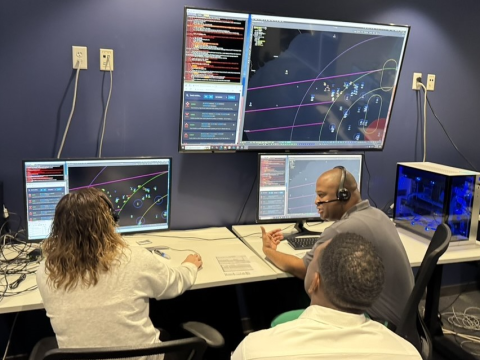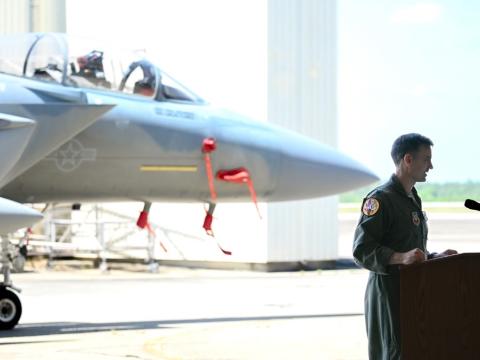Express Launch To Space
The U.S. Defense Department makes rapid access to space a top priority.
Within the next decade, the U.S. Air Force plans to field a rapidly deployable satellite launch capability to support joint and coalition operations around the world. By working with the national research and development community, the service aims to identify and nurture technologies that will enhance the nation’s military space efforts.
Orbital space has been an important zone for reconnaissance and communications assets for nearly 40 years. Recent advances in technology, however, are leading to the development of smaller, more capable satellites. Called micro-satellites, these spacecraft—coupled with new, cost-efficient launch technologies—may offer quick-reaction, tailored systems designed to meet warfighters’ needs.
The Development and Transformation Directorate at the Space and Missile Systems Center, Los Angeles Air Force Base, is responsible for seeking out and expanding these future capabilities. According to its director, Brig. Gen. Simon P. Worden, USAF, the directorate is charged with developing and demonstrating responsive space concepts for transformational weapon systems. When a program is mature, it is assigned to a different office.
Gen. Worden notes that his command is an outgrowth of the Rumsfeld Space Commission, which called for major changes in the way the U.S. Defense Department approaches space efforts (SIGNAL, February, page 21). The commission was concerned that nearly a decade of changing operational requirements had slowed scientific development in the national security space arena. “We do a lot of good research at our laboratories, but it tends to be in basic technologies and components. We also do a good job of buying new systems when we know what we’re buying,” he says.
But an intermediate step is missing, what the general calls “the lost art of development.” This is the process of taking a program out of the laboratory and working on it until it is deemed mature enough to build a system. This step includes experiments, demonstrations, and concept and development work. “We’re really trying to focus on that end—development, demonstration and so forth—prior to actually making a decision to deploy a new capability,” the general maintains.
This approach is part of a broader Air Force push toward a capabilities-based acquisition method that is not centered on individual systems (SIGNAL, May, page 35). Such a process requires a different type of development cycle to test new concepts. Gen. Worden notes that one of the Rumsfeld Commission’s recommendations for substantially increasing space-related funding for the Defense Advanced Research Projects Agency (DARPA) has already been approved by Congress. The funding, which is beginning to reach the agency, will exceed $500 million a year for quick-launch-responsive space and hypersonic propulsion development.
Gen. Worden explains that one of his command’s primary concerns is research into rapid, responsive space capabilities to put tailored payloads in orbit. Development is being focused on small, low-cost vehicles to launch micro-satellite-size payloads in short order. Working with DARPA on the Operational Responsive Space Lift Effort, the Air Force seeks to shorten its launch preparations from months to days. A major part of this task is reducing payload size from thousands of pounds down to hundreds, he explains. Currently, even if a satellite is ready for launch, it takes several months to prepare it and up to a month or more of diagnostic tests while in orbit to ensure that it is functioning properly. “If we look at something like the war in Iraq, you would have liked to have new capabilities that could have been put up in a few days and tailored based on the need—whether they’re communications, surveillance or support,” he observes.
The Air Force also is attempting to define and control what it refers to as tactical space—low earth orbit. The service is conducting a major analysis called Operationally Responsive Space that will be completed this fall. The general notes that DARPA’s space-lift efforts are an initial step in this direction. The service is exploring different types of payloads that can be modified for specific missions.
A priority for researchers is developing a full concept of operations to determine how these new space capabilities can support tactical operations. “We’re about halfway through the process, but fundamentally we want to treat space no differently from any other kind of support,” Gen. Worden offers. For example, an air operations center could work with the Air Force Space Command to put more communications assets in orbit over a combat zone. It may be possible to configure some systems in orbit and offer a variety of support functions such as reconnaissance, intelligence, navigation or weather satellites for quick launch, he speculates.
The ultimate goal is to provide a seamless capability to meet field commanders’ requests by launching unmanned aerial vehicles, manned aircraft or spacecraft in time for effective support. “I want to emphasize that we’re thinking about this, not in terms of being a space thing but as a capability we are delivering. And we will deliver the most effective, affordable service, considering the circumstances. That’s a new mindset for the space community and for the rest of the military community—to think of space as just another capability, and one that you can actually have on short time scales,” he says.
Another area of focus is space control. To defend its space-based assets, the Air Force has initiated a number of programs to develop fast-response space situational awareness capabilities. Initiatives are underway with DARPA, the Air Force Research Laboratory and other services such as the Naval Research Laboratory to move these space programs forward, Gen. Worden shares.
The general cites his prior experiences working with NASA on its “faster, better, cheaper” efforts and the Strategic Defense Initiative as influences for his command’s emphasis on meeting operational capabilities first and obtaining specific equipment second. “They [NASA] no longer look at it in terms of whether it’s this program or that program. That’s been a very effective approach that we are now using across the Air Force and Defense Department. I think there is a slow revolution in the way we think about buying new systems, new capabilities,” he explains.
The Air Force also is looking at commercial endeavors, such as the X-Prize, as a source for new technologies. Based on the aeronautical contests of the early 20th century, the X-Prize competition began in 1996 and offers $10 million to the first commercial firm that can successfully launch a reusable manned spacecraft into low earth orbit twice in two weeks. Gen. Worden is one of the founding sponsors of the contest. He notes that there are three or four competitors with promising technologies that may be applied to responsive space capabilities.
Additional research is underway to develop the ability to deploy satellite constellations by launching multiple micro-satellites from a single platform. The work involves collaboration between the Air Force Research Laboratory and NASA.
But exploiting tactical space poses a number of challenges. Because space launch continues to be expensive, many of the Air Force’s efforts focus on producing low-cost methods to deliver payloads into orbit. New propulsion technologies will help, but the United States has not done much in several decades to move new systems further along. “We really need to revitalize that area,” the general observes.
A major undertaking in this area is the National Aerospace Initiative (NAI). A joint Defense Department and NASA program, NAI is working to develop air-breathing and hypersonic propulsion capabilities. “When we eventually get around to building next-generation access to space, the first stage may well be an air-breathing system, and we’re very intrigued with that potential,” he says.
The NAI is working on a variety of rocket systems such as pressure-fed and hybrid engines. The general notes that both of these technologies show great potential for lower operating costs and more responsive access to space. He speculates that a fully reusable vehicle that combines air-breathing and rocket stages may be feasible in 10 to 15 years.
Micro-satellite development is another area where national efforts lag. A micro-satellite is defined as a spacecraft weighing less than 1,000 pounds. Development work in the United States and Europe seeks to produce craft in the 100- to 200-pound range. Spacecraft under 40 pounds are referred to as nanosatellites. Gen. Worden notes that, in 2002, roughly a dozen micro-satellites were launched into space, none from the United States. “Frankly, the rest of the world has stolen our march. The most advanced micro-sat progress has been made outside the United States. It was sort of an unpleasant thing to learn—although not a shock so much as a challenge,” he says. To close this gap, the general believes the aerospace industry must speed up development and focus on applications and uses for small satellites.
Declining manpower in the aerospace sector also is causing concern. Gen. Worden notes that fewer young people are entering the industry. “We’re kind of running out of people. I’m sort of disappointed when I visit a contractor and all the people are older than I am—and I’m no spring chicken. We’ve really got to get a new generation of the best and brightest in these areas, and responsive space is one way to do it,” he says. The general adds that the space race was in full swing when he was in college. Everything seemed possible within a short time span. He notes that, at the time, NASA went to the moon in nine years and that the cycle from system concept to orbital deployment was often as little as two years.
“I think we’ve got a chance to do that again, and that will attract the very best folks. But it’s not a moment too soon. This is really a national problem, and I think we’re beginning to see a national focus back on how important the whole aerospace capability is to our economic and national security,” he says.




Comments